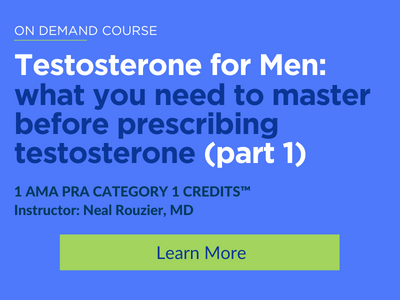
Testosterone for Men: Facts, Figures and Literature that you Should Know Before Prescribing Testosterone

Testosterone for Men: Facts, Figures and Literature that you Should Know Before Prescribing Testosterone
The more articles that demonstrate the benefits of testosterone, the more there is pushback against the use of testosterone. Every day I encounter a PMD or specialist that criticizes my use of testosterone, despite the fact that I educate patients to not divulge this information to their doctors. Nevertheless, it still occurs. More disconcerting, is the fact that some doctors urge their patients to sue the prescribing doctor if there is ever a bad outcome and then I get to defend them. Therefore, I felt that it would be pertinent that I do a series of lectures outlining the various cases that I have had to defend, how I successfully defended them, and the literature utilized that everyone needs to have in their library and place on patients charts. The appropriate chart documentation is outlined in Part I of the BHRT Workshop Series, so I will skip those points.
CASE:
A 37 y/o obese male weighing 375 pounds presents to a physician requesting help with weight, symptoms, and the desire to start testosterone which he has read much about. After being on HRT for 6 months, the patient lost 50 pounds which he was unable to accomplish despite multiple diets and exercise programs. Unfortunately, the patient suffered a fracture/dislocation of his ankle requiring OR&F. Post-op the patient suffers a PE and dies. The physician is sued for prescribing testosterone that the plaintiff’s attorney claims never should have been prescribed in the first place as the TT levels were 350. The attorney claims that if the doctor would have simply prescribed a diet, that the testosterone would normalize on its own. Plaintiff’s attorney did not like me after a defense verdict was awarded by the jury.
Boneyard
Objectives:
1) Review current guidelines as to diagnosis of hypogonadism, both symptomatically and biochemically.
2) Understand why current guidelines are incorrect and should be adjusted on current medical studies and not FDA restrictive opinion.
3) Examine the medical literature that I presented that proved guidelines were wrong and that the prescribing physician was correct in prescribing testosterone despite the patient falling outside of current guidelines.
4) Understand treatment goals should be symptom improvement and clinical parameters and not based on a number.
5) Review why current guidelines recommend no testosterone use in men with CVD.
6) Review why testosterone is the best treatment for men with CVD
